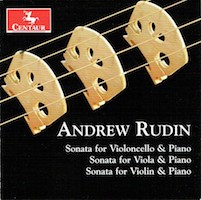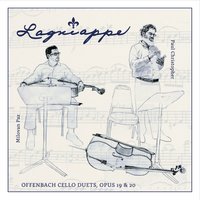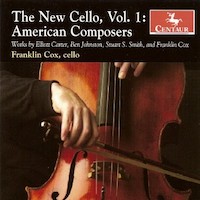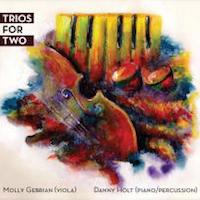String Theory 26: Some Duos, Duets
|
Grant Chu Covell [March 2018.]
“Divertimenti.” Robert FUCHS: 12 Duette, Op. 60 (1898). Ernst TOCH: Divertimento, Op. 37, No. 2 (1926). Bohuslav MARTINŮ: Duo No. 2 (1950). Miller Porfiris Duo: Anton Miller (vln), Rita Porfiris (vla). MP2 Records (1 CD) (http://www.millerporfirisduo.org/). Energetic and superbly well-matched, the Miller Porfiris Duo offers what appear to be the first complete performance of Fuchs’ overlooked 12 Duets. Written by a teacher of Mahler and Korngold, these pieces sparkle and delight. A friend to Brahms, we should know more of this neglected Viennese composer’s music. Another Fuchs student, Toch wrote this expressive and not particularly dissonant duet several years before he fled Europe for America. Apparently two-thirds of the “Million Dollar Trio” recorded excerpts due to a misunderstanding: Heifetz had prepared the wrong piece (Op. 37, No. 1 is for violin and cello) and convinced Piatigorsky to read the viola part of Op. 37, No. 2 instead. Also in three movements, like Toch’s Divertimento, the Martinů Duo is crisp and lively in its outer Allegros but somber in a central Lento. There is no mistaking this composer’s harmonies and angular Mozartisms. (“Duo No. 1” is the more familiar Three Madrigals for violin and viola from 1947.) This release was privately made but has excellent sound quality, notes and presentation.
“Viola Works.” Axel Borup-JØRGENSEN: Partita for Solo Viola, Op. 15 (1953-54)1; Music for Percussion and Viola, Op. 18 (1955-56)2; O Bäume Lebens, Op. 81 (1977)3; Sonata for Viola and Piano, Op. 14 (1952-53)4; Mobiles after Alexander Calder, Op. 38 (1961)5; Duo for Violin and Viola, Op. 12 (1951-52)6. Anette Slaatto1,2,3,4,5,6 (vla), Christina Bjørkøe2,4,5 (pno), Signe Asmussen3 (m-sop), Helge Slaatto6 (vln), EKKOZONE2, Mathias Reumert2,5 (perc, cond.). Dacapo 8.226584 (1 CD) (http://www.dacapo-records.dk/). Violist Slaatto leads us through a wonderful anthology of Borup-Jørgensen’s chamber music. Inheriting the concise chromatic grammar set free by Bartók, this Danish composer passed through Darmstadt in the 1950s and appears to have remained consistently modernist in outlook. Individual movements in the solo Partita and the athletic interlocking Duo balance short motives with distinctive rhythms. Borup-Jørgensen (1924-2012) is a natural and effective composer for percussion: Music for Percussion and Viola, which includes piano and a large percussion ensemble, does not necessarily limit the viola to melody or the ensemble to raw gesture. Scored for independently proceeding viola, marimba and piano, the Mobiles reflect Calder’s sculptures. O Bäume Lebens sets Rilke convincingly for mezzo-soprano and viola.
“The Complete Sonatas for Two Violins.” Jean-Marie LECLAIR: Six Sonatas for Two Violins, Op. 3 (1730); Six Sonatas for Two Violins, Op. 12 (1747). Greg Ewer, Adam Lamotte (vln). Sono Luminus DSL 92176 (2 CDs, 1 Blu-ray) (http://www.sonoluminus.com/). Virtuoso Leclair created the French school of violin playing. Famously temperamental, he vacated a royal appointment rather than yield his principal chair. He was murdered in 1764, a crime that remains unsolved. This release appears to be the first to combine both sets of violin duos published 17 years apart (53:23 + 70:26). The Op. 3 Sonatas are never argumentative, but consistently bright and energetic. Frequent double-stopping produces the illusion of more than a duet. The Op. 12 group is more settled, less catchy than its predecessor. The later sonatas can be more contrapuntal, as in Op. 12, No. 3’s Andante built as a chaconne. The two players alternate melody and accompaniment, requiring subtlety and balance which Ewer and Lamotte effervescently supply.
“Three String Sonatas.” Andrew RUDIN: Sonata for Violoncello and Piano (2010)1; Sonata for Viola and Piano (2007)2; Sonata for Violin and Piano (in one movement) (2001)3. Miranda Cuckson3 (vln), Brett Deubner2 (vla), Samuel Magill1 (vlc), Beth Levin1, Marcantonio Barone2, Steven Beck3 (pno). Centaur Records CRC 3266 (1 CD) (http://centaurrecords.com/). These are not easy sonatas, but they are rewarding. Written in a salty and bold style, their strong melodic lines and motives sustain interest across large spans. Rudin stems proudly from gruff American stock like Rochberg, who was a teacher and friend. The cello sonata has Debussy’s Sonate as an unlikely reference point, whereas the incrementally increasing movement durations establish Rudin’s stated appreciation for Lutosławski’s formal patterns. The viola sonata includes specific references to Rochberg’s Second Symphony, and, like the single-movement violin sonata, was expanded into a concerto. At 20 minutes, the violin sonata explores phases and moods. Rudin does not crowd the frame. There is immense room for expression and energy, and it’s clear that these performers (in different venues in 2009 and 2011) enjoy this music and what it stands for.
“Lagniappe!” Jacques OFFENBACH: École du Violoncelle: Trois Duos Très Faciles dédiés aux Commençans, Op. 19 (1839); École du Violoncelle: Trois Duos Faciles, Op. 20 (1839). Paul Christopher, Milovan Paz (vlc). Human Metronome HMP 107-2016 (1 CD) (http://www.humanmetronome.com/). With this release, we stumble onto the tail end of an ambitious project, equal parts arcane and intriguing. Offenbach was a celebrated cello virtuoso before he turned to creating music for the stage, activities that he is most remembered for today. This release is the seventh dedicated to Offenbach’s pedagogical duets and progressive studies. These six tuneful pieces are actually the easiest in the long stretch of his two-cello output: Opp. 19-21, 34 and 49-54. At two or three movements each, they do not strain a listener’s attention, even though their technical ease steers them towards simple motives and harmonies. The able soloists are separated at right (Christopher) and left (Paz).
“The New Cello, Vol. 1: American Composers.” Elliott CARTER: Figment (1994); Figment 2, “Remembering Mr. Ives” (2001). Ben JOHNSTON: Toccata (1984); Duo for Two Violins (1978; arr. for two cellos by Franklin COX, 2005). Stuart Saunders SMITH: Willow (2003); Said, nearly (1996). Franklin COX: Clairvoyance (1989); Recoil (1994). Franklin Cox (vlc). Centaur Records CRC 2994 (1 CD) (http://www.centaurrecords.com/). Once past the distant acoustic, literally, since Cox’s cello sounds far away, we enter a world of bracing freshness and acuity. Cox’s broad-minded attitude towards intonation and pitch color may not please everyone. Four composers are represented twice each. We start with the coarsest Carter you may ever hear, shaped with expressive inflections to contrast the dramatic voices, especially effective in the Ives Figment. Johnston’s music specifically inhabits the just intonation universe: The Toccata saws briskly, the tart cello Duet (Fuga, Aria and Toccata) is achieved through multi-tracking. The longest opus, Smith’s Said, nearly is actually eight movements played in an order chosen by the performer. The composer considers the creation of music an autobiographic action. Not just because the shorter piece is titled Willow does this music suggest a journey in the great outdoors. These works provide Cox opportunities to plumb the cello’s expressive capabilities and wide tessitura. His own pieces are the most involved. Recoil finds microtones (the whole step is subdivided into 12) and the hands may operate independently. Vol. 2 was covered here.
“Trios for Two.” Casey CANGELOSI: Theatric No. 8 (2010). Karl BLENCH: Second Take (2010). Daniel CORRAL: Ultramarine (2010). Christopher GODDARD: Third Nature (2010). Ingrid LEE: Nomentum (2010). CHIAYU: Black and White (2015). Molly Gebrain (vla), Danny Holt (pno, perc). Innova 966 (1 CD) (http://www.innova.mu/). To satisfy that particular yen for music for viola, piano and percussion, here is a remarkable release of duos for that combination. Yes, duos: A single player doubles piano and percussion. For the most part, the pianist / percussionist keeps busy with stick(s) in one hand while playing the keyboard with the other. For good measure there are also foot pedals and sometimes a whistle. (It is unclear whether Gebrain ever does double duty.) Cangelosi’s work is a steady gust of minimalist gestures in complex meters and spiky tonality. The pop influence is proudly evident, but the mechanics are intentionally broken. Blench and Corral hungrily maximize the team’s potential and keep Holt active. Second Take’s five parts are energized miniatures, except for the chorale-like viola and piano conclusion. Goddard’s Third Nature tells a story of conflict and combination, and as its title hints, deals with threes. We enter the land of less is more with Lee’s Nomentum, wherein the duo explores unpleasant sounds (grinding, playing on the wrong side of the bridge, etc.). Chiayu’s title contains the names of its two contrasting movements. Based upon the title, I had thought Black was first and White second, and found the music unexpectedly strange. However, Chiayu does meet expectations: The slower, calmer White precedes the shorter, alert Black.
Blench, Borup-Jørgensen, C Goddard, Cangelosi, Carter, Chiayu, Corral, F Cox, Fuchs, I Lee, Johnston, Leclair, Martinů, Offenbach, Rudin, SS Smith, Toch
[More Grant Chu Covell, String Theory]
[More
Blench, Borup-Jørgensen, C Goddard, Cangelosi, Carter, Chiayu, Corral, F Cox, Fuchs, I Lee, Johnston, Leclair, Martinů, Offenbach, Rudin, SS Smith, Toch]
[Previous Article:
Used Bin Troll Tweets FF.]
[Next Article:
Lying down with Stax phones 3.]
|






